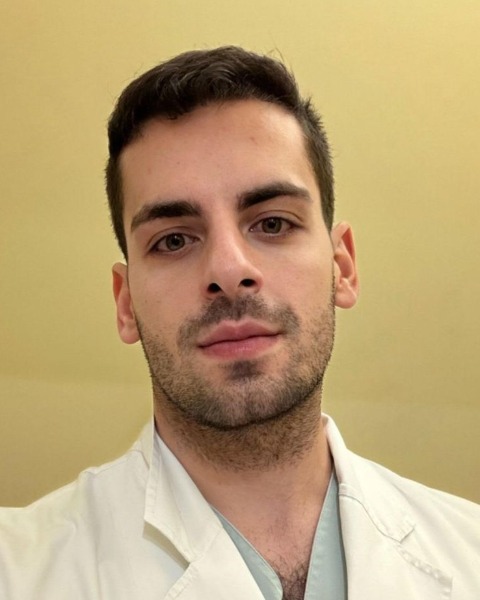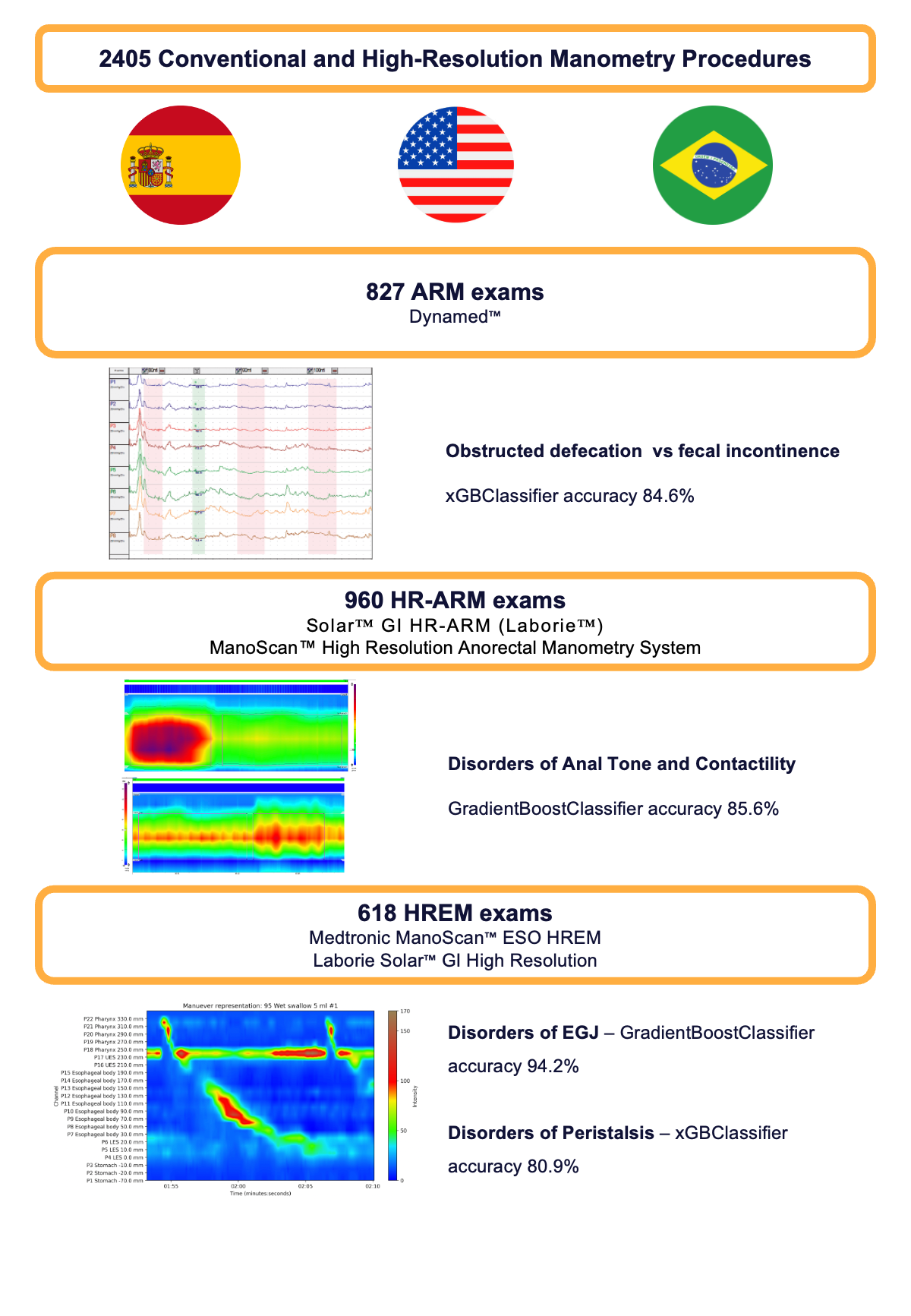Sunday Poster Session
Category: Functional Bowel Disease
P0795 - Advancing GI Motility With AI: A Transatlantic Multicentric Study of Cross-Site and Cross-Device Manometry Analysis
Sunday, October 26, 2025
3:30 PM - 7:00 PM PDT
Location: Exhibit Hall

Miguel Mascarenhas, MD, PhD
Centro Hospitalar Universitário São João
Porto, Porto, Portugal
Presenting Author(s)
Award: ACG Presidential Poster Award
Francisco Mendes, MD1, Miguel Mascarenhas Saraiva, MD, PhD1, Joana Mota, MD1, João Rala Cordeiro, PhD2, Miguel Martins, MD1, Maria João Almeida, MD1, Pedro Cardoso, MD1, Joana Frias, MD1, Catarina Araujo, MD1, Ilario Froehner, Jr., MD3, Ismael Hajra Martinez, MD4, Virginia Matallana Royo, MD4, Benjamin Niland, MD5, João Ferreira, PhD6, Jack Di Palma, MD, MACG5, Cecilio Santander, MD, PhD7, Guilherme Macedo, MD, PhD1
1Centro Hospitalar Universitário São João, Porto, Porto, Portugal; 2Telecomunications Institute, University Institute of Lisbon,, Lisboa, Lisboa, Portugal; 3Department of Gastrointestinal Motility, Nossa Senhora das Graças Hospital, Curitiba, Parana, Brazil; 4Department of Gastroenterology, Hospital Universitario Puerta de Hierro Majadahonda, Madrid, Madrid, Spain; 5Division of Gastroenterology, University of South Alabama, Mobile, AL; 6Faculdade de Engenharia da Universidade do Porto, Porto, Porto, Portugal; 7Department of Gastroenterology, Hospital Universitario La Princesa, Madrid, Madrid, Spain
Introduction: Since its early development, manometry has been fundamental in the diagnostic workup of functional esophageal and anorectal motility disorders. Nevertheless, these exams are hindered by complex data analysis and high interobserver variability. Additionally, there is still a significant gap between low (where conventional manometry is still performed) and high-resource settings (where high resolution devices prevail).
In this context, artificial intelligence offers the promise of creating an unified framework for interoperable manometry classification. This study aims to develop and validate artificial intelligence models for classification of motility disorders in both conventional anorectal manometry (CARM), high-resolution anorectal manometry (HR-ARM) (according to London Classification) and high-resolution esophageal manometry (HREM) (according to Chicago Classification).
Methods: Multiple machine learning (ML) models were developed and tested after inclusion of exams from 4 centers in 3 countries. 827 ARM exams were used for development and testing of 4 ML models, with 90% of the data used for training and 10% for testing. 960 HR-ARM exams were used for development of ML models according to London Classification, with a 80%/20% patient split. Finally, 618 HREM exams were used for development of ML models according to Chicago Classification, with a 80%/20% patient split. Model’s performance was evaluated through metrics as accuracy and the area under the receiver-operating characteristic curve (AUC-ROC).
Results: The xGBClassifier discriminated obstructed defecation from fecal incontinence in ARM with an overall accuracy of 84.6% and AUC-ROC of 0.939. Considering HR-ARM, GradientBoostingClassifier identified disorders of anal tone and contractility with an accuracy of 85.6% and an AUC-ROC of 0.910.Finnaly, disorders of the esophagogastric junction outflow were identified by GradientBoostingClasifier with an accuracy of 94.2% and AUC-ROC of 0.921, while the xGBClassifier detected disorders of peristalsis with an accuracy of 80.9% and AUC-ROC of 0.871.
Discussion: In this study with an interoperable and multicentric design, the GradientBoostingClassifier and xGBClassifier automatically identified motility disorders in ARM, HR-ARM and HREM. This study showcases the promise of AI-driven manometry, which could revolutionize functional gastrointestinal field trough increment in exam accessibility and accuracy.

Figure: Figure 1 – Study Design and Results from an Interoperable Model for Classification of Motility Patterns in conventional anorectal manometry (ARM), high—resolution anorectal manometry (HR-ARM) and high-resolution esophageal manometry (HREM)
Disclosures:
Francisco Mendes indicated no relevant financial relationships.
Miguel Mascarenhas Saraiva indicated no relevant financial relationships.
Joana Mota indicated no relevant financial relationships.
João Rala Cordeiro indicated no relevant financial relationships.
Miguel Martins indicated no relevant financial relationships.
Maria João Almeida indicated no relevant financial relationships.
Pedro Cardoso indicated no relevant financial relationships.
Joana Frias indicated no relevant financial relationships.
Catarina Araujo indicated no relevant financial relationships.
Ilario Froehner, Jr. indicated no relevant financial relationships.
Ismael Hajra Martinez indicated no relevant financial relationships.
Virginia Matallana Royo indicated no relevant financial relationships.
Benjamin Niland indicated no relevant financial relationships.
João Ferreira indicated no relevant financial relationships.
Jack Di Palma indicated no relevant financial relationships.
Cecilio Santander indicated no relevant financial relationships.
Guilherme Macedo indicated no relevant financial relationships.
Francisco Mendes, MD1, Miguel Mascarenhas Saraiva, MD, PhD1, Joana Mota, MD1, João Rala Cordeiro, PhD2, Miguel Martins, MD1, Maria João Almeida, MD1, Pedro Cardoso, MD1, Joana Frias, MD1, Catarina Araujo, MD1, Ilario Froehner, Jr., MD3, Ismael Hajra Martinez, MD4, Virginia Matallana Royo, MD4, Benjamin Niland, MD5, João Ferreira, PhD6, Jack Di Palma, MD, MACG5, Cecilio Santander, MD, PhD7, Guilherme Macedo, MD, PhD1. P0795 - Advancing GI Motility With AI: A Transatlantic Multicentric Study of Cross-Site and Cross-Device Manometry Analysis, ACG 2025 Annual Scientific Meeting Abstracts. Phoenix, AZ: American College of Gastroenterology.
Francisco Mendes, MD1, Miguel Mascarenhas Saraiva, MD, PhD1, Joana Mota, MD1, João Rala Cordeiro, PhD2, Miguel Martins, MD1, Maria João Almeida, MD1, Pedro Cardoso, MD1, Joana Frias, MD1, Catarina Araujo, MD1, Ilario Froehner, Jr., MD3, Ismael Hajra Martinez, MD4, Virginia Matallana Royo, MD4, Benjamin Niland, MD5, João Ferreira, PhD6, Jack Di Palma, MD, MACG5, Cecilio Santander, MD, PhD7, Guilherme Macedo, MD, PhD1
1Centro Hospitalar Universitário São João, Porto, Porto, Portugal; 2Telecomunications Institute, University Institute of Lisbon,, Lisboa, Lisboa, Portugal; 3Department of Gastrointestinal Motility, Nossa Senhora das Graças Hospital, Curitiba, Parana, Brazil; 4Department of Gastroenterology, Hospital Universitario Puerta de Hierro Majadahonda, Madrid, Madrid, Spain; 5Division of Gastroenterology, University of South Alabama, Mobile, AL; 6Faculdade de Engenharia da Universidade do Porto, Porto, Porto, Portugal; 7Department of Gastroenterology, Hospital Universitario La Princesa, Madrid, Madrid, Spain
Introduction: Since its early development, manometry has been fundamental in the diagnostic workup of functional esophageal and anorectal motility disorders. Nevertheless, these exams are hindered by complex data analysis and high interobserver variability. Additionally, there is still a significant gap between low (where conventional manometry is still performed) and high-resource settings (where high resolution devices prevail).
In this context, artificial intelligence offers the promise of creating an unified framework for interoperable manometry classification. This study aims to develop and validate artificial intelligence models for classification of motility disorders in both conventional anorectal manometry (CARM), high-resolution anorectal manometry (HR-ARM) (according to London Classification) and high-resolution esophageal manometry (HREM) (according to Chicago Classification).
Methods: Multiple machine learning (ML) models were developed and tested after inclusion of exams from 4 centers in 3 countries. 827 ARM exams were used for development and testing of 4 ML models, with 90% of the data used for training and 10% for testing. 960 HR-ARM exams were used for development of ML models according to London Classification, with a 80%/20% patient split. Finally, 618 HREM exams were used for development of ML models according to Chicago Classification, with a 80%/20% patient split. Model’s performance was evaluated through metrics as accuracy and the area under the receiver-operating characteristic curve (AUC-ROC).
Results: The xGBClassifier discriminated obstructed defecation from fecal incontinence in ARM with an overall accuracy of 84.6% and AUC-ROC of 0.939. Considering HR-ARM, GradientBoostingClassifier identified disorders of anal tone and contractility with an accuracy of 85.6% and an AUC-ROC of 0.910.Finnaly, disorders of the esophagogastric junction outflow were identified by GradientBoostingClasifier with an accuracy of 94.2% and AUC-ROC of 0.921, while the xGBClassifier detected disorders of peristalsis with an accuracy of 80.9% and AUC-ROC of 0.871.
Discussion: In this study with an interoperable and multicentric design, the GradientBoostingClassifier and xGBClassifier automatically identified motility disorders in ARM, HR-ARM and HREM. This study showcases the promise of AI-driven manometry, which could revolutionize functional gastrointestinal field trough increment in exam accessibility and accuracy.

Figure: Figure 1 – Study Design and Results from an Interoperable Model for Classification of Motility Patterns in conventional anorectal manometry (ARM), high—resolution anorectal manometry (HR-ARM) and high-resolution esophageal manometry (HREM)
Disclosures:
Francisco Mendes indicated no relevant financial relationships.
Miguel Mascarenhas Saraiva indicated no relevant financial relationships.
Joana Mota indicated no relevant financial relationships.
João Rala Cordeiro indicated no relevant financial relationships.
Miguel Martins indicated no relevant financial relationships.
Maria João Almeida indicated no relevant financial relationships.
Pedro Cardoso indicated no relevant financial relationships.
Joana Frias indicated no relevant financial relationships.
Catarina Araujo indicated no relevant financial relationships.
Ilario Froehner, Jr. indicated no relevant financial relationships.
Ismael Hajra Martinez indicated no relevant financial relationships.
Virginia Matallana Royo indicated no relevant financial relationships.
Benjamin Niland indicated no relevant financial relationships.
João Ferreira indicated no relevant financial relationships.
Jack Di Palma indicated no relevant financial relationships.
Cecilio Santander indicated no relevant financial relationships.
Guilherme Macedo indicated no relevant financial relationships.
Francisco Mendes, MD1, Miguel Mascarenhas Saraiva, MD, PhD1, Joana Mota, MD1, João Rala Cordeiro, PhD2, Miguel Martins, MD1, Maria João Almeida, MD1, Pedro Cardoso, MD1, Joana Frias, MD1, Catarina Araujo, MD1, Ilario Froehner, Jr., MD3, Ismael Hajra Martinez, MD4, Virginia Matallana Royo, MD4, Benjamin Niland, MD5, João Ferreira, PhD6, Jack Di Palma, MD, MACG5, Cecilio Santander, MD, PhD7, Guilherme Macedo, MD, PhD1. P0795 - Advancing GI Motility With AI: A Transatlantic Multicentric Study of Cross-Site and Cross-Device Manometry Analysis, ACG 2025 Annual Scientific Meeting Abstracts. Phoenix, AZ: American College of Gastroenterology.

